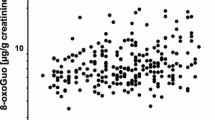Abstract
Objective: Association between genetic deletion polymorphism of GSTM1 (*0/*0 or active) and levels of anti (±)-r-7,t-8-dihydroxy-t-9,10-oxy-7,8,9,10-tetrahydrobenzo[a]pyrene (anti-BPDE)-DNA adducts in the peripheral blood lymphocyte plus monocyte fraction (LMF) of PAH-exposed subjects was investigated. Methods: A total of 94 Caucasian subjects comprised the sample population: 13 coke-oven workers, 19 chimney sweeps, 36 aluminum-anode plant workers, and 26 non-occupationally PAH-exposed subjects (controls). PAH exposure was assessed in each group by means of the urinary excretion of 1-pyrenol (mean group levels 1.2, 0.7, 0.3, and 0.1 μmol/mol creatinine in coke-oven workers, chimney sweeps, aluminum-anode plant workers, and control subjects, respectively). Anti-BPDE-DNA adducts were detected by HPLC/fluorescence analysis of anti-BPDE tetrols (tetrol I-1) released after acid hydrolysis of DNA samples. Results: In coke-oven workers the percentage of cases with adduct levels exceeding the 95th percentile control value (4.4 adducts/108 nucleotides) was significantly higher in the subgroup with the null GSTM1 genotype (*0/*0) (100%) than in that with active GSTM1 (43%; 2 test, P < 0.05). In the other groups with different and lower levels of PAH exposure the percentages of positive samples were always higher in the subgroup with GSTM1 *0/*0 than in the active one, although the differences were not statistically significant. Univariate (odds ratio) and multivariate (relative risk) analyses showed that the risk of having high anti-BPDE-DNA levels increased with occupational exposure to PAH. Such risks, moreover, were further significantly increased by the lack of GSTM1 activity (RR = 5.94; CI = 1.15–30.7; P < 0.05). In coke-oven workers, chimney sweeps, and aluminum workers, respectively, the multiplicative effect of the null genotype with occupational PAH exposure gives risks of 162 (=27.2 × 5.94), 10 (=1.70 × 5.94), and 3 (=0.50 × 5.94) times higher probability (risk) of high BPDE-DNA adduct formation than that of nonexposed subjects with the active GSTM1 genotype. Conclusion: Our results indicate a greater risk of anti-BPDE-DNA adduct formation resulting from occupational high-level PAH-exposure in GSTM1 null (GSTM1 *0/*0) workers.
Similar content being viewed by others
Author information
Authors and Affiliations
Additional information
Received: 17 December 1998 / Accepted: 19 March 1999
Rights and permissions
About this article
Cite this article
Pavanello, S., Gabbani, G., Mastrangelo, G. et al. Influence of GSTM1 genotypes on anti-BPDE–DNA adduct levels in mononuclear white blood cells of humans exposed to PAH. Int Arch Occup Environ Health 72, 238–246 (1999). https://doi.org/10.1007/s004200050367
Issue Date:
DOI: https://doi.org/10.1007/s004200050367




